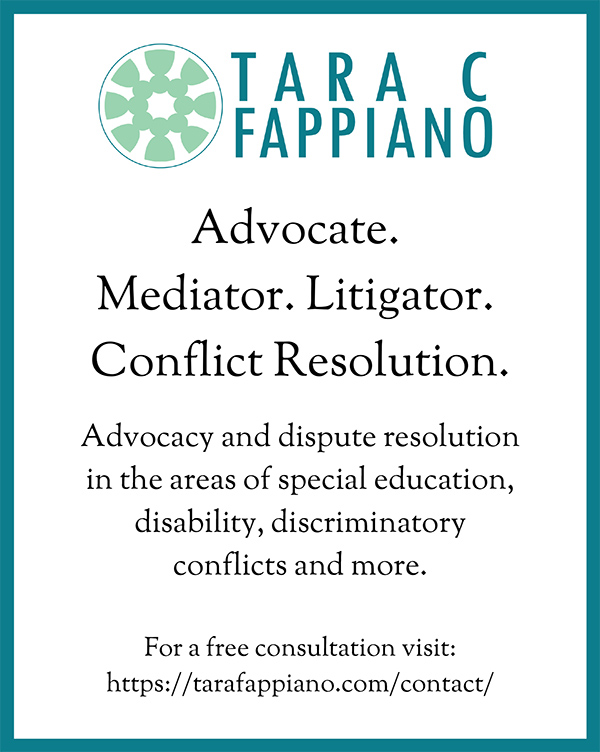When conflict arises in an educational setting, there are multiple ways to resolve it. Some are small and easily resolved but may potentially lead to bigger conflicts and issues. Sometimes the conflict is substantial, and a resolution harder to achieve. Understanding different available methods of resolving conflict can help families and educators decide the best pathway toward resolution. The expense, time, and adversarial nature of the conflict increases proportionately through each stage of the process. As those increase, a student’s path to success becomes increasingly frustrated.

Tara C. Fappiano, Esq.
Prevention
In the educational setting, conflict can and should be avoided before it arises. Using the example of a new school year, Parents and families often face that year, with new teachers, with trepidation. The teacher does not know their child. They may not have a full understanding of the child’s particular disability or learning challenge. Parent and student alike may have a lot of anxiety in facing the unknown or transitioning into a new environment. Left unaddressed, there is great risk of conflict arising.
Working collaboratively, parents and teachers can do much to minimize that risk. An understanding that the teachers or support staff are also getting acclimated to a new situation is key. Teachers need time to know the student, so parents should not assume there will be problems. When that first contact is made, respect for each party’s role will go a long way toward collaboration. Those early discussions can focus on agreements as to the best way to communicate, how often, and what information may be needed from each party for the student to succeed. Sharing concerns and information openly creates a great working relationship. When two parties establish an open communication path early on, with the student’s interests at the center, the likelihood that a conflict will be avoided, or resolved more easily if one arises, is increased tremendously.
De-Escalation and Problem-Solving
Even in the best of circumstances, conflicts arise in the classroom. Sometimes, the conflict is a small disagreement. Sometimes there is an identified problem, but a different opinion about whether or how to best resolve it. Sometimes, the conflict is bigger. There may be a “task-based” conflict, which usually arises when something about the learning environment is not appropriate for the student. Or there may be a “relationship-based” conflict, whether real or perceived. It is quite tempting, for parents in particular, to assume or perceive there is a relationship-based issue. As an advocate, I frequently hear first from parents that the teacher does not like them, or that the teacher does not want to listen to anything they say, or even worse that the teacher or school has it “out for them.” This type of thinking, even if there is some truth to it, gets in the way of resolving what is actually a task-based conflict. If the parties can see through those types of categorizations to focus on the actual problem at hand, resolution is much more attainable.
If the parties really are interested in resolution, de-escalation at this stage is crucial. There is still an opportunity to avoid further expense, and to get the student back on track, quickly. So, how to do that? Set up an informal meeting, in person, to speak about what specific issues have been identified with the student, whether in the classroom or from the parents’ perspective. Be open to hearing the perspective of the persons relaying the information. If what is being discussed is confusing, seems inconsistent, or is not specific enough, use constructive questioning to find out more. Ask for the other party to propose a solution, then try to discuss those solutions with an open mind. More times than not, the parties can arrive at a proposed solution if both are at least willing to try. If there is a concern, by either party, that this will not fully resolve the conflict, agree when to re-group to evaluate the situation again.
In my work as an advocate, I am very often contacted when conflicts have not been de-escalated. Either the parties have not attempted to do so at all, or there has been a meeting that did not go well. There may be multiple attempts at the school level to de-escalate. The introduction of an attorney or outside advocate into the situation at this stage may cause a school to put up more barriers. But, an advocate skilled in negotiation and experienced in conflict resolution can do a great deal to achieve de-escalation. In my experience, most families want there to be de-escalation above all else. So, in deciding whether to retain an advocate at this stage they should understand the approach that will be taken before moving forward.
Facilitation
If conflicts cannot be de-escalated, the next stage of conflict resolution is the involvement of a neutral. In the education setting, that would usually involve a mediation. A mediator uses a variety of techniques to work with the parties to facilitate a resolution of the conflict. A mediator does not judge the facts, or rule on the law – but they understand both. A skilled mediator also understands that there is stress, emotion, and prior history between the parties that may be influencing decision making. A skilled mediator will also seek to guide the parties toward realistic agreements that will resolve the conflict, with practical application, and good measures of success. Mediators do not issue rulings; they help parties come to an agreement on their own.
It is not required that the parties participating in mediation have legal representation, nor is mediation mandatory under most circumstances. There are also varying venues or programs used by school districts, depending on location. Some districts rarely use mediation, while others will participate, but not meaningfully, while still others embrace the process. So, before agreeing to mediation, families should understand the process in their particular case. They should inquire whether the school district will have an attorney represent it. They should have a clear understanding as to whether there will be a cost to the parties for the mediation process. Many mediators will hold pre-mediation meetings to discuss these types of logistics.
An advocate or attorney who is skilled in negotiation also can be a tremendous asset in the mediation process. Successful mediations will result in a settlement of the issues. It is also important to understand whether the settlement reached at mediation will result in a written agreement that may later be enforced. If so, mediation is a way to avoid the need for expensive litigation. Litigation is also invariably a lengthy process and will never result in immediate solutions in the classroom that will help a student in the short term.
Arbitration
Arbitration is an alternative way to resolve disputes outside the courtroom. An arbitrator is also a neutral. Unlike a mediator, the arbitrator listens to the evidence from both sides and issues a decision. Arbitration may be binding, which can help the parties avoid litigation, and can be faster than litigation. But it can also be expensive, as both sides will almost always retain attorneys and the arbitrator must also be paid a fee. The arbitration process also does not allow the parties to compromise, collaborate, or work on a solution together. So, the risk of loss is much higher.
Avoiding the Courtroom
Litigation should be viewed as a last resort when conflicts arise in the educational setting. There are times, however, when litigation simply cannot be avoided. For example, there may be a concern of waiving claims or defenses under the applicable law. Attorneys should be consulted whenever a parent is concerned of such a risk. However, litigation does not foreclose the ability to resolve a dispute through negotiations, mediation, or arbitration. These options should always be considered, as the goal should always be to get students back on the path toward success, quickly, with minimal disruption.
Tara C. Fappiano is an advocate, mediator, conflict resolution coach, and attorney. Using conflict resolution techniques and collaborative dispute resolution practices, she works with the special needs community to help with issues that arise with special education and other services. She also offers conflict management coaching and mediation for organizations, non-profits, businesses, school districts and related entities. For more information, email tcf@tarafappiano.com, call (917) 923-2330, and visit www.tarafappiano.com.





